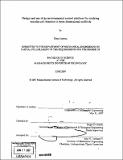| dc.contributor.advisor | Roger D. Kamm. | en_US |
| dc.contributor.author | Jäätmaa, Iliana (Iliana Nicole Vera) | en_US |
| dc.contributor.other | Massachusetts Institute of Technology. Dept. of Mechanical Engineering. | en_US |
| dc.date.accessioned | 2008-02-27T22:26:41Z | |
| dc.date.available | 2008-02-27T22:26:41Z | |
| dc.date.copyright | 2007 | en_US |
| dc.date.issued | 2007 | en_US |
| dc.identifier.uri | http://hdl.handle.net/1721.1/40446 | |
| dc.description | Thesis (S.B.)--Massachusetts Institute of Technology, Dept. of Mechanical Engineering, 2007. | en_US |
| dc.description | Includes bibliographical references (p. 33). | en_US |
| dc.description.abstract | Endothelial and smooth muscle cells are the core of the vascular system. Vessels are created and repaired through the processes of angiogenesis and arteriogenesis. Endothelial cells are the initial cells that migrate and proliferate during the process, followed by smooth muscle cell movement and differentiation. The recruitment of smooth muscle cells is not fully understood, and if understood would unlock a crucial step in the growth and remodeling of vessels. Endothelial and smooth muscle cells have been extensively studied in two dimensional models and the physiologic factors that affect their function and survival have been well documented. In living organisms, vascular tissue, consisting primarily of endothelial and smooth muscle cells, grows in three dimensions where it is constantly exposed to biochemical and biomechanical stimuli. Thus, a controllable three dimensional environment is desired to study these interactions. The cells do not move instantaneously or in direct paths, hence, it is beneficial to be able to study the cells at multiple time points and over long periods of time. Most in vitro studies have not been conducted for more than 100 hours, while in vivo experiments have been continued for months. | en_US |
| dc.description.abstract | (cont.) To fully understand in vitro growth of smooth muscle cells, the growth should be monitored continually and the observation technique must be able to support to this. Accordingly, we have developed a microscope stage environmental chamber that houses a three dimensional bioreactor for vascular tissue engineering in order to monitor tissue function in real-time. We have demonstrated the capabilities of the environmental control chamber by growing smooth muscle precursor cells (10Tl/2 cells) in the three dimensional bioreactor and monitored the cells for growth, migration and proliferation. Critical to the chamber design was the control of temperature, carbon dioxide concentration, and humidity. Furthermore, smooth muscle precursor cell (10T1/2 cell) migration and morphology was observed in response to varying concentrations of Platelet Derived Growth Factor-BB (PDGF-BB), an endothelial cell-derived growth factor that is important for smooth muscle recruitment to remodeling blood vessels. Using a migration assay technique that observes the general trends of cell movement through the device, the cells exposed to PDGF-BB have been noted to move more than the cells grown in media without a growth factor. The cells tend to migrate towards the PDGF-BB with great variability. | en_US |
| dc.description.statementofresponsibility | by Iliana Jaatmaa. | en_US |
| dc.format.extent | 33 p. | en_US |
| dc.language.iso | eng | en_US |
| dc.publisher | Massachusetts Institute of Technology | en_US |
| dc.rights | M.I.T. theses are protected by copyright. They may be viewed from this source for any purpose, but reproduction or distribution in any format is prohibited without written permission. See provided URL for inquiries about permission. | en_US |
| dc.rights.uri | http://dspace.mit.edu/handle/1721.1/7582 | |
| dc.subject | Mechanical Engineering. | en_US |
| dc.title | Design and use of an environmental control platform for studying vascular cell function in three-dimensional scaffolds | en_US |
| dc.type | Thesis | en_US |
| dc.description.degree | S.B. | en_US |
| dc.contributor.department | Massachusetts Institute of Technology. Department of Mechanical Engineering | |
| dc.identifier.oclc | 191730831 | en_US |
